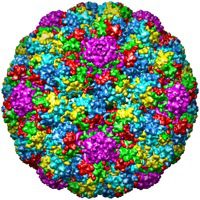

There are five known human polyomaviruses: JC and BK, both isolated in 1971, and the more recently discovered KIV, WUV, and MCV (Merkel cell polyomavirus). The percentage of the human population that is infected with these viruses has been addressed by determining whether antibodies directed against the viral capsid protein VP1 are present in sera.
A total of 1501 serum specimens from healthy blood donors were examined. The presence of antibody to the viruses – known as seroprevalence – was 82% for BKV, 39% for JCV, 15% for LPV, 55% for KIV, 69% for WUV, and 25 and 42% for two different MCV strains. The sampling error is plus or minus 1%. Seroprevalence of these viruses was also examined in samples from 721 children, and the results were similar to those obtained with adult sera. From this information the authors conclude that polyomavirus infection of humans probably occurs during childhood.
The authors also determined the level of antibodies to a monkey polyomavirus, SV40. This virus was introduced into millions of people as a contaminant of early preparations of inactivated and infectious poliovirus vaccines. Whether or not the virus causes tumors in humans is a matter of scientific and legal controversy. Only 2% of the specimens were positive for antibodies to SV40. The low seroprevalence of antibodies to SV40 suggest that this virus does not circulate extensively among humans.
Given the high seroprevalence of polyomaviruses in humans, it is not surprising that they are significant pathogens in immunosuppressed populations. An important question is why these viruses can peacefully co-exist in many humans without causing disease. Are human polyomaviruses simply passengers, or do they benefit us in some unknown way?
Kean, J., Rao, S., Wang, M., & Garcea, R. (2009). Seroepidemiology of Human Polyomaviruses PLoS Pathogens, 5 (3) DOI: 10.1371/journal.ppat.1000363

How does it work with co-existence with viruses? Are they, from their preferred cell, always releasing viral particles that are attacked as soon as they are released, or is there something about immunosuppresants that somehow indicates a 'go ahead' to start replicating and spreading?
I suppose it just makes me wonder how many of these viruses are just sitting there waiting for their chance.
Pingback: Merkel cell polyomavirus, a new oncogenic human virus?
they say 8% of the human genome is made up of retroviruses so i guess they actually become part of self / the host, and therefore are no longer recognised by the immunesystem as invaders . i understand these may at times come in and out of latency . otherwise they are considered latent permanent infections . my biology traning suggested the cell has ways to archive and remember foreign nucleic acid sequences . something i read said the junk viruses or junk dnas somehow adds stability to the genome . the science and medical community has been tampering with these complex mechanisms for decades . is there any reason to wonder why so many young are dying ?
i believe mitogenic substances can compound viral infections / dioxins , estrogens and etc.
Looks like you’ve done your research very well.